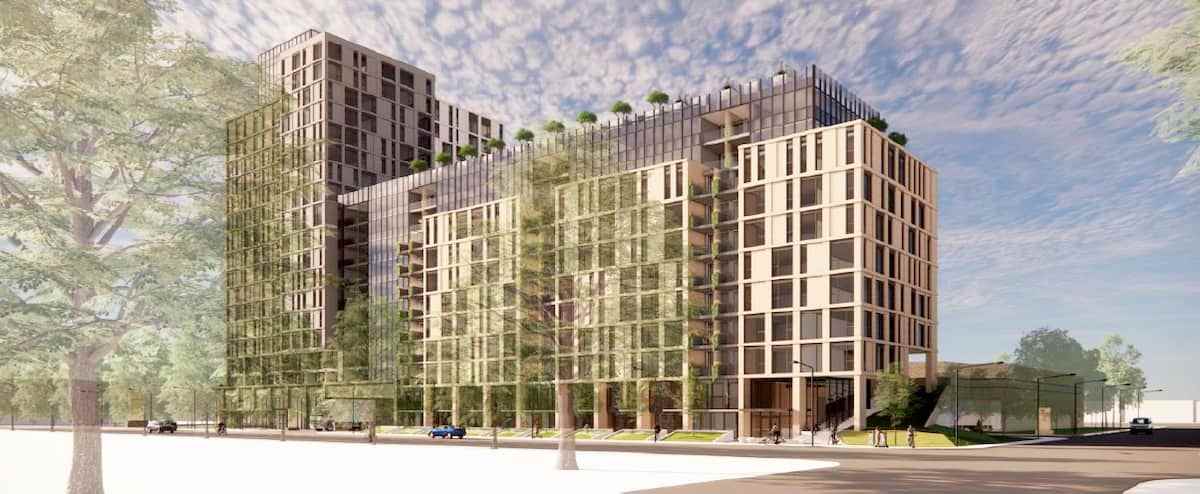A real estate boom is taking shape around the extension of the blue line of the Montreal metro while promoters want to build many residential towers in Anjou and Saint-Léonard.
• Read also: Metro construction site in Anjou: the STM will do everything to limit nuisances
The borough of Anjou this month approved a project by real estate giant First Capital, which wants to build 241 homes on the land of the Toys ”R” Us store.
The promoter plans to demolish the neighboring Hart store to build two towers of 11 and 20 floors just opposite the future terminus of the blue line in Anjou.
“We haven’t reached the permit stage yet, but, yes, we have approved [le projet]it would be something that we would see there, ”comments the mayor of Anjou, Luis Miranda.
He notes that, since the announcement of the metro extension, many promoters have been “testing the waters”.
In September, Anjou’s planning advisory committee was in favor of a three-tower project with a maximum of 20 floors comprising approximately 860 dwellings on the land of a car dealership, a stone’s throw from the future Anjou station.
In December, another developer had also obtained the approval of the borough to build three residential buildings of 8 to 19 floors on the ground of the shopping center Les Halles d’Anjou.
He stepped down earlier this month, but Mr Miranda expects him to return with another project.
Thousands of accommodations
In the neighboring borough of Saint-Léonard, the real estate giant Groupe Mach intends to carry out a project of several thousand housing units on the site of Carrefour Langelier, which will also house a metro station.
The company headed by Vincent Chiara acquired this vast complex for $60 million in 2020. “We acquired it with the intention of redeveloping it by keeping tenants and adding residential,” says the Group’s first vice-president. Mach, Pierre-Jacques Lefaivre. This is a project that will span 10 years. »
He says it’s too early to give a specific number of units, but it will be in the thousands.
“I can’t say yet because it’s still zoned commercial. But we are not talking about building two 150-door towers, we are in the thousands, ”said Mr. Lefaivre.
Welcome development
Without commenting on these projects, the borough indicates that a redevelopment of this sector will be “positive”.
“This sector is currently made up of large parking lots that serve the population poorly, in particular by being large heat islands, and it is not very attractive,” said Saint-Léonard spokesperson Julie Blais.
That said, not all projects will end up under construction.
First Capital wanted to add housing to its Place Viau shopping center, at the corner of this boulevard and the Metropolitan highway, but the borough refused its project.
Upcoming rounds on commercial land
Anouk Lebel
The Journal of Montreal
Developers’ interest in commercial land around future blue line metro stations is not surprising, according to an expert.
“All along the metro, we should see 20-storey towers,” explains Jean-Philippe Meloche, professor and director of the School of Urban Planning at the University of Montreal.
According to him, many commercial lands are called upon to accommodate residential projects as the extension of the blue line materializes, as is the case of the project of the giant First Capital (see other text).
“If we improve the accessibility of a place, it changes the value of the land. Developers and owners will try to maximize the value of the land,” he points out.
At the Galeries d’Anjou
Even the owner of the Galeries d’Anjou, Ivanhoé Cambridge, does not hide his interest in building homes on his land.
“We are not going to reveal the plans. We have a lot of projects under discussion right now. Housing, logistics, there are many things that become very attractive from the moment we have a metro station on the site,” said yesterday the CEO of the real estate arm of the Caisse de dépôt et placement du Québec ( CDPQ), Nathalie Palladitcheff, during the presentation of the organization’s financial results.
The mayor of Anjou, Luis Miranda, says he is ready to see the landscape change.
“It is clear that it will intensify. It is no longer a question of making single-family homes in the city. Around the metro, it’s going to have to be affordable for people to go downtown,” he says.
– With Martin Jolicoeur

